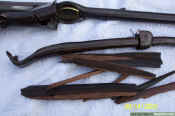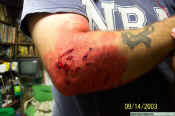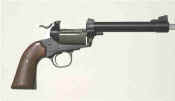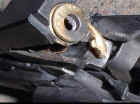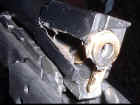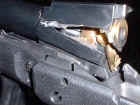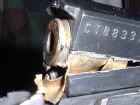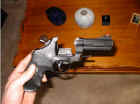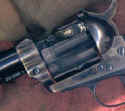Oversize
Bullets, Reduced Powder Charges
and
other Blowup Stories
by Jim Taylor
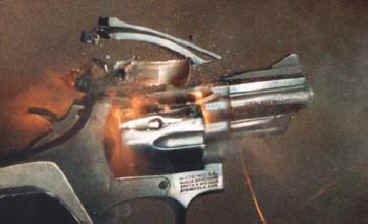
From an e-mail :
Last weekend I came close to loosing a dear friend. He and I used to own a 50 BMG rifle and reloading stuff together. We still have the reloading stuff but he blew the kapock out of the rifle. The receiver is stretched out at the area of the locking lugs, three of the six lugs on the bolt are cracked visibly, the bolt flew back fast enough to put a 1/4 inch dent in the metal shoulder piece, one extractor is in half and the other is missing entirely, the case is "welded" into the chamber with the middle of the case head gone, or actually vaporized and sprayed on the receiver, bolt, and my buddy.
The rifle, a nice British WWI anti-tank gun is history. On the lucky side, my buddy is not history. After 4 days he can get his right eye open where the scope whacked him. He has been in to the docs 4 times to to sew him up and to get metal taken out of his head and right hand, but he will heal up, and for that I continue to thank God. As soon as he is up to it I am going to kick my buddy's ass around the block. Not for the rifle, but because of the risk he took. As it turns out, his mistake was a simple one. He used a very mild load of the wrong powder. A normal load is in the neighborhood of 250 grains of the slowest powder made. He used 200 grains of a powder intended for .223 and .308 by mistake. He bought several one gallon jugs of powder a couple of years back and was SURE that he knew which was for what. Well, he remembered wrong and it could have killed him. Glad he didn't go for the full load.
Between us we have loaded in the neighborhood of 10,000 rounds without a mishap. Reloading is fun and it can be done safely, but not if you are not careful or if you are not paying attention. Please, Please, Please follow all the rules, Don't drink or smoke while reloading, Don't use suspect components, Wear eye protection, If you don't know the rest of the list please read any reloading manual.But PLEASE if you are not absolutely sure, don't do it. Look it up, preferably in a couple of source. Please be safe.
I don't know if you have ever seen a gun blow up or not, but it's not funny. If someone is not injured when it happens it is due more to the intervention of God, Guardian Angels and the good engineering and craftsmanship of manufacturers than anything else. I have been present at blowups but thankfully, none of them were mine. I did blow a gun on purpose once. It was rigged to fire by remote control and was housed in a container that held all the parts and pieces. It was a controlled experiment. It went the way it was planned and I learned what I needed to know. That's a different thing. I am glad the gentleman mentioned in the e-mail was not seriously injured or killed.
Thank God blowups do not happen all that often. But happen they do. Since the advent of Cowboy Action Shooting and more and more people getting into reloading I have heard of more blowups than I did in the years previous. There seems to be a lot of mystery surrounding why blowups happen. Some of the mystery is introduced because no one likes to admit they screwed up. "I can't understand it!" is commonly heard. "I don't know what happened." " It is the same load I have been shooting for years," is a whole lot easier to say than, "I must have double-charged that case." or "Gosh, I used the wrong powder!"
I was on the range one day and a young man was shooting a Colt 1911 .45 ACP beside me. I had stepped back from the firing line to do something and was sort of watching him when he fired a funny-sounding round. It did not sound like a normal shot. The magazine fell into the dirt as his feet, he turned his head toward me and said in a shaky voice, "It blew up." He was holding the pistol two-handed and as he released his hold slightly the grips fell to the ground in several pieces. I could see he was slightly "dingy" so I stepped over and took the gun out of his hands which were blackened with smoke.
After we got him set down and determined he was not injured I examined the gun. The slide was locked about 1/4 of the way back. It was cracked around the ejection port. Later I took it apart and found it came very close to blowing the slide completely in two. The barrel was swelled till the chamber was nearly .60 caliber. The slide was bulged and the frame rails were bent slightly. The frame was later put back into service after determining it was not cracked. It is still functioning 20 years later. The shooter said, "I don't know what happened. It just....blew up."
Over-Pressure
That blowup was not due to the alignment of the planets, sunspots, or some mystical force of spirits. The metal stress showed one likely cause. High pressure. The powder that the shooter was using could have easily been double-charged in the ACP case and most likely was. Among reloaders this is one of the more common causes of blowups. And one that is almost never admitted.
If you reload, develop the habit of double and triple checking your powder charges BEFORE you seat that bullet!! Save yourself some grief.
AND .... MAXIMUM LOADS are just that -- MAXIMUM. Stay away from anyone who flirts with over-maximum loads. They are dangerous to themselves and to anyone near them. I have seen parts of blown guns go 50 feet or further .... shrapnel is shrapnel whether it comes from a land mine or blown up firearm.
Those who want to "push the envelope" and who think they know more than ballistics engineers should be considerate enough to have a good medical policy, life insurance, and do their shooting in places where other people will not be endangered.
AND... if you are one of those who thinks everything is OK just because you have been doing it for quite a while and your gun is fine ... read on please.
Borrowed Reloads
Another common cause of blowups is SHOOTING SOMEONE ELSE'S RELOADS. It probably is a toss-up between this one and double-charging the powder for First Place in the "Why Guns Blow Up Contest". I have seen more guns ruined by people who shot other people's reloads. I had a friend who blew the top off the cylinder of his Ruger Security Six with a friend's reloads. This "friend" said, "I hear you reload your ammunition. So do I. Try these. They're pretty hot!" (Which should have been a warning sign!!) On my range here at the ranch a friend wrecked a beautiful old Colt by shooting someone's reloads. We were having a shoot and he wanted to use his old Colt. Not having any shells for it he borrowed some from someone before he came. The first shot bulged the cylinder so badly against the topstrap that the topstrap was bent. It did not blow up, but it was about .010" from it. It completely locked up the gun.
Wrong Powder
Using the wrong powder unknowingly has contributed to wrecked guns as mentioned in the e-mail at the beginning of this article. I have seen rifles blown by someone inadvertently using pistol powder in the rifle cartridges. Or using loading data for one powder while actually using a faster powder. P.O. Ackley wrote about was a Model 70 Winchester in .270 that was blown when the reloader used loading data for IMR 4350 but in actuality IMR 3031 was the powder being used. Maximum charges for 4350 were used which would have been safe. The 3031 was enough faster that the gun was completely wrecked.
Make sure you are using the correct powder for the charts you are using. Double-check it!
Barrel Obstructions
Of course there are the "common" reasons for blowups. Barrel obstructions is one that is common. Sometimes it comes from a bullet being left in the barrel when a shell is ejected. If the bullet is seated over maximum length for the rifle and engages the rifling when chambered, if it is not fired sometimes the bullet can be "pulled" and left in the throat. Any obstruction near the chamber will usually cause the action to blow. This is due to high-velocity gases coming back into the receiver when the obstruction is encountered.
Another common obstruction is mud or snow in the muzzle. This will not usually blow the action, but will split the barrel quite often. Less common is a bullet jacket being left in the barrel. Some years ago a lot so-called "experts" hyped this one, focusing on taking military bullets, cutting the tips off and using them for game bullets. Supposedly the core would blow out and leave the jacket in the barrel. The next shot would then blow the gun up. Sounds logical. But is it true?
P.O. Ackley took military bullets, cut the tips off, melted the cores out, shoved the jackets down to the middle of the barrels and fired a full load up through them. Other than slightly ringing the barrel no adverse effects were ever noted. (Not that you want a ring in your barrel, but the point was to see if the gun would break from it.) Conceivably a complete barrel obstruction could cause a blowup. But the hollow jackets were just a tube. No air could compress behind them and the bullet just passed through it on its way out the barrel.
Still, if you have a jacket stop in the barrel I would advise against trying to shoot it out. You do not want to be replacing barrels. It gets expensive and can be embarrassing at the least.
Wrong Ammunition
The wrong ammo will sometimes blow a gun - especially in rifles. If a .35 Remington is fired in a .30-06 it can be horrible. This is due more to the cartridge not sealing the chamber and allowing high-pressure gas into the action which tears it apart, than it is to the oversize bullet. If the cartridge seals the chamber the pressure will go down the barrel, resizing the bullet in the process.
Speaking of P.O. Ackley again, he once took a standard .30-06 chamber, enlarged the throat so it would accept .35 caliber bullets, then seated .35 caliber bullets into the .30-06 and fired them through the .30 caliber bore. Using standard .30-06 charges behind the .35 caliber 180 gr. Barnes bullets, no undue signs of pressure were noted. The bullet was re-sized to .30 caliber by the time it had moved very far, then passed through the rest of the bore easily. But if the cartridge case does not seal the chamber, all that pressure comes rushing back into the action and destroys it. This was a controlled test in a laboratory. DON'T TRY THIS AT HOME.
Use the proper ammo for the gun!!
By the way, Mr. Ackley was not one to just take someone's word for things. He would often experiment to prove whether something was true or not. If you do not have his HANDBOOK FOR SHOOTERS AND RELOADERS Vol. 1 & 2 in your library you are missing some good stuff.
All his testing was done under controlled
conditions and in an environment where no one's safety was at risk. He did
not just load up a bunch of ammo and head off to the range!
Reduced Charges
Reduced powder charges have been blamed for lots of blowups. Quite a few people have spent years trying to get a gun to blow up with reduced charges and have been unsuccessful. P.O. Ackley tried most of his life and never did get one to blow with reduced charges. That it does happen is undeniable. Just exactly "Why" is another question that remains to be answered as it has not been replicated in laboratory tests. Usually in rifles it is in combination with large, over-bore cases and light charges of slow-burning powder.
In handguns for years it was target loads - specifically the .38 Special caliber, 148 gr. wadcutters, and light charges of Bullseye. Quite a few shooters complained it blew up their guns. Among others, Hercules (now Alliant) published a pamphlet about their tests since so many were complaining the light charges of Bullseye blew their guns up. They went so far as to use a dynamite cap instead of a primer in a modified .38 Special case fired in a Colt Detective Special. It did not blow the gun even though they detonated the powder. There is just not enough explosive charge in the small amount of powder to create an over-pressure situation.
However, if you use a double-charge of powder, pressures run up very high. And if the bullet gets seated too deeply into the case, pressures can go off the charts as tests showed. Even seating a bullet 1/10" of an inch deeper can raise pressures considerably when you are already at the peak pressure.
If you have a "squib" load ( one that "poops") you can have problems, especially if a bullet is left in the barrel. With a load that "poops" the powder does not keep burning and the bullet stops in the barrel. If there is considerable amount of unburned powder left in the barrel behind the bullet ( which is now a barrel obstruction) and then you fire another one up behind it, conceivably the powder left in the barrel can be ignited. That along with air being highly compressed in the barrel can cause a blowup. So far this is the only way "Light Powder Charge Blowups" have been duplicated in laboratory tests, especially in rifles. I know of at least one handgun - a Model 83 Freedom Arms - that was blown in half by this happening, the frame separating just in front of the cylinder. Pressures had to be simply ENORMOUS!
Several years ago SHOOT MAGAZINE ( www.shootmagazine.com ) ran an article about 3 .45's blown up by light loads within the space of one year by the same reloaders. The first time they thought it was the "light charge detonation" theory at work. The second time ... a mistake? When the third one went - all with the same powder charge and bullet - they began to search. To make a long story short, what happened was that during the reloading process on a progressive reloader, bullet lube would collect in the stem of the bullet seating die. As a round came through every once in awhile the bullet would be pulled from the case and stick up inside the seating die. The next round through then received 2 bullets seated and crimped into the case.
They weighed their loaded cartridges and found some with double bullets. In the article they had a photo of one they sectioned. Pressures had to be enormous. I have a hunch that this has caused more blowups than we know.
In addition, light charges of slow-burning powders is not recommended in handguns. H-110, WW-296 and like powders should not be used for reduced charges. We have plenty of faster powders that work well for lighter, slower velocity loads. Use one of them. Avoid potential problems. Why court trouble?
Stoppages
I have seen handguns that had a bullet stop in the bore and then a full load fired up behind them. I have never seen a handgun blown from this though it is possible. I remember a .44 Magnum that had a bullet stop halfway down the barrel and a factory load 240 gr. fired up against it. It left an "egg" (egg-shaped bulge) in the middle of the barrel, but other than that it did not harm the gun. It shot OK with the bulge! I mean, it would shoot into less than 2" at 25 yards with all loads. They changed the barrel later 'cuz it was strange looking and no one wants to use a strange-looking gun.
A friend brought a Colt Gold Cup .45 to us one day. His kids had been using it and it quit working. The slide was locked shut. We got it open and found the barrel was bulged into the slide from a stoppage that had been fired out of it. It egged the barrel till the slide would not move. On a whim Dad turned down the outside of the barrel, re-assembled the gun and took it to the range. He fired a number of groups with it and they averaged 1 1/2" at 25 yards. So he gave the gun back to the owner and he is still using it that way 15 years later!
I do not say this to encourage you to shoot stoppages out of your barrel. Any obstruction is potentially dangerous. If it is close to the breech it is worse. All the ones above were down the bore a ways. The gun I blew on purpose had a bullet shoved into the barrel until it was flush with the end of the throat. Then an overload (which had not hurt the gun previously) was fired behind it. It blew the cylinder and broke the frame.
I had the gun in a chamber that contained all the pieces and it was fired by remote control, by the way.
Other Reasons
There are lots of other reasons for gun blowups. Some ammunition was made that used improperly annealed brass. The brass would not stand normal pressures and blew back into the action. It happened.
There have been blowups caused by gunsmiths who improperly re-chambered a firearm. People can invent new ways to do things, even destructive things, faster than we can tell others to watch out!
Another reason is - METAL FATIGUE. Yep .. you can over-stress metal only so long.
Well Dudes, I had her since I was 20 (1974) and she's gone now. Took a mess of whitetail with it and was planning on taking it out to Colorado next month for elk. The '86 was made in '03 and was not nickel steel. It has logged 1846 rounds of which most have been warm. The load that blew it was 40 grains of A.A. 5744 behind a 330 Rapine for 1725 FPS. I fired about 240 rounds of this load in the past 2 months getting ready for the elk trip. I had that load down! 3" groups @100 meters and 5" at 200 meters. Sighted 6" high, it was point blank out to 200 which was my limit with an open tang sight.
Today, while shooting these loads over a chronograph (benchresting) I was getting very consistent velocities and then the round before the blow up registered 1509. I thought it was a mistake so I put it out of my mind. The next shot blew. The guy two benches down said it did not sound any louder than the previous rounds. If I was holding the gun in an offhand position, I would not have a right hand. I am a left handed shooter so my right arm was wrapped to my left arm pit. The forend was shattered in many pieces. Wood from the forend was imbedded in the benchtop. More was imbedded in my right arm. I pulled out 1/2" pieces (about 10 in all). Many more smaller pieces were stuck in my arm. By hey! The Lord was with me and He saw to it my eyesight and other vital items were left intact. I was on the verge of shooting offhand but He made me shoot some more off the bench.
Well, thanks for listening guys and it looks like I'll be taking the old 1886 in 33 to bag my elk.---Sixgun
I talked to Accurate Arms today and the technician told me the load was running about 32,000 pounds. He too told me it was metal fatigue as the locking bolts of the receiver were undamaged (all internals were fine) and the case in the ruptured barrel still had the primer in it and did not show excessive pressure. The barrel was of the earlier blackpowder steel even though when they made my rifle back in 1903, nickel steel was available. (common practice back then)Jim Taylor contacted me and wants to use the pix in an article.. . he has my full permission.
Above all, READ AND STUDY the RELOADING MANUALS! The ballistics engineers actually do know what they are doing. Keep the basic safety and reloading rules in mind and enjoy our sport. We want to stay safe and healthy, have a good time, and enjoy our firearms.
